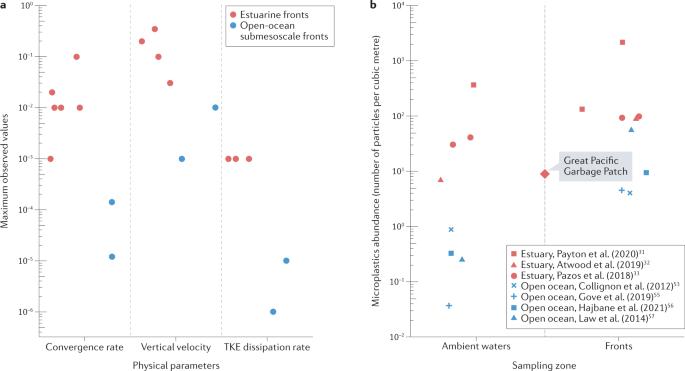Accumulation, transformation and transport of microplastics in estuarine fronts
引用次数: 11
Abstract
Millions of tons of riverine plastic waste enter the ocean via estuaries annually. The plastics accumulate, fragment, mix and interact with organisms in these dynamic systems, but such processes have received limited attention relative to open-ocean sites. In this Perspective, we discuss the occurrence and convergence of microplastics at estuarine fronts, focusing on their interactions with physical, geochemical and biological processes. Microplastic transformation can be enhanced within frontal systems owing to strong turbulence and interactions with sediment and biological particles, exacerbating the potential ecosystem impacts. The formation of microplastic hotspots at estuarine fronts could be a target for future plastic pollution mitigation efforts. Knowledge of the mechanics of plastic dispersal, accumulation and fate in frontal zones will, in turn, improve our understanding of plastic waste along the land–sea aquatic continuum. Large quantities of plastics flow from rivers to estuaries, where they potentially converge in frontal zones. This Perspective describes the occurrence, transformation and impact of these processes, highlighting their importance in mitigating plastic pollution.

微塑料在河口前沿的积聚、转化和迁移
每年有数百万吨的河道塑料垃圾通过河口进入海洋。塑料在这些动态系统中积聚、破碎、混合并与生物发生相互作用,但相对于公海而言,这些过程受到的关注有限。在本《视角》中,我们将讨论微塑料在河口前沿的出现和汇聚,重点关注它们与物理、地球化学和生物过程的相互作用。由于强烈的湍流以及与沉积物和生物颗粒的相互作用,微塑料在锋面系统中的转化可能会增强,从而加剧对生态系统的潜在影响。河口前缘微塑料热点的形成可能是未来塑料污染缓解工作的一个目标。了解塑料在前沿地带的扩散、积累和归宿的机理,反过来也将增进我们对陆海水生连续体中塑料废物的了解。大量塑料从河流流向河口,并有可能在前缘区汇聚。本视角描述了这些过程的发生、转变和影响,强调了它们在减轻塑料污染方面的重要性。
本文章由计算机程序翻译,如有差异,请以英文原文为准。
求助全文
约1分钟内获得全文
求助全文

 求助内容:
求助内容: 应助结果提醒方式:
应助结果提醒方式:


